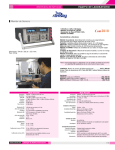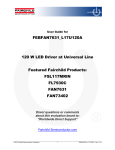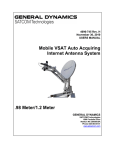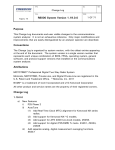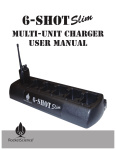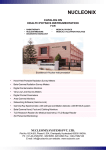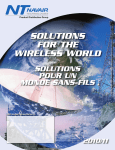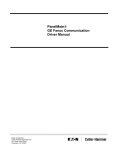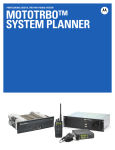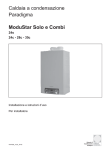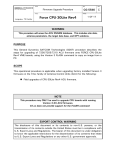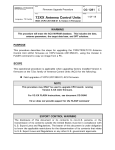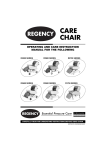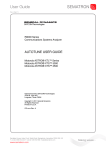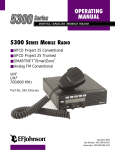Download 4 - Navair Inc.
Transcript
Communications System Analyzers The New R2600 Series, including R2600, R2625 and R2670 If you maintain, repair, calibrate, or design radio communications equipment, the R2600 family of Communications System Analyzers has a solution for you. Rugged enough to withstand heavy field use, the R2600 is designed to help you save time and work more efficiently. This platform is available in three models, each tailored to its own set of testing requirements. Features/Benefits 1) Display Zone for presentation of test data and waveforms 2) RF Control Zone for selecting RF test conditions 3) Cursor Zone keys provide simple, one-button access to any zone 4) Tuning Knob for quick and easy changes of numeric entries: Digital precision with an analog feel 5) Off-the-air antenna port for sensitive receiver measurements 6) Color LCD 7) VGA output port 8) High speed serial port for remote control operation and flash software update capability 9) User-friendly, soft-touch keys for feature selection 10) Audio Control Zone for setting modulation conditions 11) Cursor position keys allow instant cursor movement within a zone 12) Memory recall for up to 30 channels including automatic scanning plus optional 15 userprogrammable test setups 13) One-button access to special functions 14) Hard rubber bumpers on front and rear for maximum physical integrity 15) Rubberized knobs 2 The R2600 Series: The industry proven test solution for APCO™ Project 25 (Project 25) SMARTNET/ SmartZone™, ASTRO™, SECURENET™, and conventional two way radio. The R2600 family of Communications System Analyzers performs tests normally associated with these instruments: • RF Signal Generator • Sensitive Measurement Receiver • Spectrum Analyzer • Full Band Duplex Offset Generator • Frequency Counter • AC/DC Voltmeter • 50 kHz Oscilloscope • RF Wattmeter • Signal Strength Meter • Frequency Error Meter • SINAD Meter • Distortion Meter • Sweep Generator • Audio Generator • Modulation Analyzer • Signaling Simulator • RF Scan/Counter • High Performance Spectrum Analyzer with Markers Optional in R2600 & R2625; standard in R2670: • Cable Fault Locator • Tracking Generator • Programmable Test Set-Ups The R2600 family has a solution for your radio communication testing needs R2600 – For Conventional Radio and Base Station Service If you service conventional two-way systems, the value-packed R2600 is the product for you. Because of its unique design, the R2600 allows you to perform numerous complex functions with the same piece of equipment. This “one-box” design is especially useful in remote sites or where use of multiple pieces of heavy equipment is impractical – or impossible. R2625 – Economical Project 25 Solution The most cost-effective Project 25 test solution on the market, the R2625 is specifically configured for the needs of those servicing Project 25 along with conventional two-way analog systems. In addition to all of the test capabilities of the R2600, the R2625 comes standard with DESOFB Project 25 compatible Type III encryption. The R2625 also contains Project 25 diagnostic test capability, and can be optionally expanded to include the following: • Tracking Generator • Cable Fault Testing • Programmable Test Set-Up Memory • Project 25 compatible Type III AES Encryption • Project 25 Trunking R2670 – Expandable Platform for Digital, Trunked, and Secure Testing In addition to having all the capabilities found in the R2600, the R2670 FDMA digital Communications System Analyzer is a special digital hardware platform that allows customized configuration to include multiple test capabilities in one convenient package. R2670 OPTIONAL test capabilities: • SMARTNET/SmartZone Type I, I EP II, II • Project 25 Standard Conventional (IMBE) and Encrypted • ASTRO Conventional (VSELP) and Encrypted • R2680-MPT1327/1343 Test Solution Advanced Project 25 Test and Diagnostics Error Vector Magnitude The CM 816 Error Vector Magnitude (EVM) application provides a constellation diagram that gives a clear, visual picture of how close the measured signal aligns with an ideal reference. It works with C4FM, CQPSK, and LSM modulation types, and includes a user-definable tolerance setting which allows the operator to quickly visualize the performance under test. The Software also generates a histogram distribution of the EVM metrics, providing another form of visual analysis of the transmitter’s performance over time. The CM816 EVM option can be used with any R2625C model analyzer or R2670B equipped with the CM801 enhanced digital hardware module and CM813 Project 25 option. meaningful names - i.e. an ALGID of 0x80 will be shown as “Un-encrypted”. Additionally, message timing is provided with each sent and received message – especially important when working with P25 Trunking. For a lower level analysis of radio performance the symbols that are sent and received are logged and can be saved and recalled for later analysis. The Channel Logging PC application also provides a filter that allows the user to show only what is relevant to the task at hand. Channel Logging The CM815 P25 Channel Logging option provides P25 Common Air Interface data. This includes Data Unit type and a breakdown of the various message and value fields as defined by the P25 standard. Logging data is described with 3 AutoTest/AutoTune For Digital / P25 Equipped Radios Automated Test and Alignment AutoTest and AutoTune perform all recommended factory alignment procedures and critical transmitter/receiver performance tests – in a fraction of the time it takes to perform manually. Fast, accurate, easy to use The AutoTest and AutoTune software applications takes the guesswork out of aligning your radios. Simply connect the radio, select the tests and/or alignments you wish to perform from the menu, and press “Run.” The software automatically “reads” the radio’s internal programming, configures the analyzer, and takes measurements as needed. If required, internal radio adjustments are then automatically performed to bring the radio into proper alignment. All measurement results and initial/final softpot settings are stored for easy retrieval. Now even non-technical personnel can fully test and align your radios – freeing technicians to do actual repairs. 4 R2625/R2670* Analyzer Computer Motorola Radio AutoTest System Configuration *P25 conventional equipped R2670 Benefits/Features Significantly Reduced Test Times • A typical radio alignment can be completed in less than 10 minutes. • Program automatically “reads” the radio’s parameters and configures the analyzer to significantly reduce operator intervention. • Pass/Fail indication reveals defective radios. Easy to Use • Standard Windows® interface makes AutoTest simple and intuitive to operate. • No technical expertise required. • All results are automatically saved to disk and can be viewed and printed at any time. Accurate and Repeatable Results • Utilizes the R2670 or R2625 Communication Systems Analyzer for dependable performance. • Alignments and performance tests are performed according to manufacturer’s specifications. • Allows consistent alignment from radio to radio. Tests/Alignments Performed Alignments • Reference Oscillator • Transmitter Deviation Balance • Transmitter Deviation Limit Transmitter Tests • Bit Error Rate (BER) • Reference Frequency • RF Output Power Receiver Tests • Rated Audio • Distortion • SINAD Sensitivity • Noise Squelch • Voice Modulation, External • Voice Modulation, Internal Minimum Requirements for Communications System Analyzer Model R2670A/B R2625A/B/C Required options CM701/CM713 or CM801/CM813 None Firmware V6.08 V6.08 Ordering Information Radio Model Number XTS3000 XTS5000 XTS3000/5000 ASTRO SPECTRA ASTRO SPECTRA PLUS ASTRO SPECTRA/ SPECTRA PLUS AUTO TEST SUITE (includes RVN5016B & RVN5026B) Vertex Standard VX-P820/920 AutoTest/AutoTune Part RVN5012B RVN5013B RVN5016B RVN5024B RVN5025B RVN5026B RVN5027B 202621-01 5 Standard System Features Feature High Performance Spectrum Analyzer The built-in High Performance Spectrum Analyzer will display a window of RF spectrum anywhere within the 400 kHz to 1 GHz operating range of the unit. The EXPAND softkey enlarges the display to fill the LCD and retains dispersion and center frequency control. The High Performance Spectrum Analyzer adds Marker functions for more precise measurements of level and frequency (both absolute and delta). Included with the marker functions are additional dispersion selections – up to 10 MHz per division, plus the additional freeze, peak hold, and max hold features. Terminated RF Wattmeter RF power anywhere in the operating range of 400 kHz to 1GHz is automatically measured by the Communications System Analyzer when tuned to that frequency. The built-in RF load dissipates up to 125 watts for one minute. If a high power transmitter should be keyed into the unit for any longer, the LCD changes to read “WARNING RF OVERLOAD,” thus warning the technician to un-key. Programmable Test Memory Benefits The ability to observe the spectrum display for detailed analysis through the use of multiple Markers provides a significant advantage. The tuning knob retains control of the center frequency even in the EXPAND mode to perform fast sweeps or fine tuning. This allows you to quickly locate and identify signal carriers. This feature provides calibrated RF power measurements eliminating the need for a separate wattmeter. The LCD also displays frequency error and modulation level readings simultaneously. Channel Presets – The unit has 30 memory locations which can be used to store preset channel information. Channels can readily be selected individually or automatically scanned over a user-defined range. Channel Presets – This feature allows quick access to frequently used channel location information to speed testing. Scanning allows automatic monitoring and measurement of activity on channels of interest. Programmable Test Setups (standard in R2670; optional in R2600 and R2625) – You can easily program and store up to 15 of the most commonly used test configurations, including all test conditions, measurement display formats, and levels. These memory settings operate independently of the channel presets. Programmable Test Setups (standard in R2670; optional in R2600 and R2625) – You can significantly reduce the number of key presses required to set up more commonly used test configurations, greatly increasing your efficiency while promoting uniform test procedures. You can also assign a custom name to the configuration for easy recall. 6 Standard System Features – continued Feature Relative Signal Strength Meter In addition to reading frequency error and modulation, a digital readout relative signal strength meter has been included. Sensitivity is specified to -100 dBm at the antenna port for FM signals and extends up to 125 watts at the RF I/O port. The LCD display will automatically convert to a terminating “watts” display as the level increases. RF Scan / RF Counter Function Benefits This feature, in conjunction with an external antenna, allows remote monitoring of distant transmitters to check for antenna, transmission line or P.A. problems. Many users also find this feature convenient in performing propagation studies to identify weak coverage areas. RF Scan operates in the monitor mode and provides a function similar to a 1 GHz counter. This feature automatically scans a user-defined frequency range and locks on the applied signal. Any RF carrier above 20 MHz can be located within 5 seconds and the reception displayed with digital readouts. This feature allows convenient and immediate verification of the programming of a multi-channel radio. By automatically tuning the analyzer’s receiver to the detected carrier, immediate measurement data can be taken without having to enter new frequency data via the keyboard. Duplex The duplex generator provides enhanced capability to service equipment, such as repeaters and full duplex radios. Full RF level control, as well as full internal and external modulation capability allows receiver desensitization and transmitter tests to be performed simultaneously through one port, if desired. The wide offset range extends the functionality to include cross band repeater systems, as well as enhanced receiver and transmitter troubleshooting capabilities. Full output level control from -130 dBm to 0 dBm over the entire range of the instrument is available from the RF I/O port (-130 dBm up to -50 dBm) and the generator port (-80 dBm to 0 dBm). Variable offsets from 0 to ±999.995 MHz in 2.5 kHz steps are keypad-selectable. Tracking Generator (standard in R2670; optional in R2600 and R2625) The combining of the capabilities of the sweep generator and the spectrum analyzer into a Tracking Generator function allows the user to view the performance characteristics of many RF filter devices. Display range is operator selectable from a 200 kHz window up to a 50 MHz window anywhere in the 400 kHz to 1GHz spectrum. Signaling Simulator: Encoder and Decoder Diagnosis and adjustment of critical receiver front ends, IFs, helical filters, cavities, combiners and duplexers can be made in a few minutes, quickly and easily with the flexibility of a tracking generator at your fingertips. The System Analyzer includes the capability of encoding and decoding PRIVATE LINE (PL), DIGITAL PRIVATE LINE (DPL), and single tone sequences as well as multi-tone sequences including DTMF signals, 5/6 tone paging, Select V and up to 20 sequential tones. Decoding displays include tone frequencies and time durations of the individual tones. The unit can also encode tone remote signaling. The signaling capability of the unit reaches a broader range of service applications with its decode capability. This gives you a more flexible test instrument which aids in servicing paging equipment and specialized signaling encoders, as well as mobile, portable and other radio products. The signaling simulator can perform a full system check-out faster, with more accuracy than ever before. General Purpose & Modulation Oscilloscope Recovered audio or internally produced audio can be displayed visually for deviation measurements. Additionally, detection of an asymmetric modulation or audio distortion can be achieved with waveform analysis. With internal and external triggering and a freeze display single sweep, this unit duplicates many features of more expensive scopes. The markers allow detailed analysis to measure waveforms displayed on the LCD. The EXPAND function provides an enlarged, easy to interpret view of the signal for quick analysis. The oscilloscope has a 50 kHz bandwidth for audio waveform analysis. The display can be triggered over the full screen range to a fixed reference level. Triggering in both automatic and normal modes is provided for synchronizing the horizontal timebase to the vertical input signal. Internal or external inputs allow observation of both generated and monitored modulation signals. Softkeys provide for an enlarged full screen display. Flash Upgradable Software High-Speed serial port and flashable memory permit programming firmware updates from an external PC. Cable Fault (standard in R2670; optional in R2600 and R2625) Cable fault and length are RF measurement features which help the technician isolate cable defects. Supported by on-screen prompts and user-selectable Help messages, you can quickly set up and accurately determine the distance to a fault on a coaxial cable. The distance to fault (or cable length) is computed and displayed in feet or metric units. RS-232/Serial Interface (standard) IEEE-488-2 Interface (optional) A full bi-directional RS232 port is standard and includes the capability to respond to serial input command vocabulary and return measurement results as a serial output stream. Included are user-selectable baud rates (up to 115.2 Kbps) and start, stop and parity bit selection. In addition, this dual function port can drive a serial printer to print out data and graphic displays. The optional IEEE remote interface option contains the necessary hardware and software for IEEE-488.2. Quick and easy access to future software updates. Cable fault locating techniques are mandatory for site servicing, where visual inspection is not practical, safe, or effective in detecting hidden or cold-flow damage. The semi-automatic operation of the cable faultfinder precludes the use of mathematical formulas and manual calculations, maximizing your on-site productivity. If you have large volume repetitive testing requirements, this feature allows you to write your own programs to reduce test time costs. Printed results can be used as part of the service shop’s internal quality control system and can be used to demonstrate performance to the radio equipment user. 7 SMARTNET/SmartZone (Available on R2670 only) Feature Dynamic Call Testing of Subscriber Radios This feature tests Motorola compatible Type I, Type II, SmartZone and ASTRO IMBE/VSELP trunked mobile and portable radio units under actual signaling conditions. This is achieved by simulating the function of the trunked fixed-end equipment. The radio access control channel is provided to perform initial registration. A thermometerstyle graphic indicator shows call progression as it directs the radio to a traffic channel for parametric measurements and voice testing. Radio-initiated or system-initiated tests can be performed in either the phone interconnect or dispatch call modes. Dynamic Call Testing allows you to test auto affiliation for SMARTZONE systems. An additional RF synthesizer provides simultaneous control and traffic channels, operator selectable over the entire band of allowable channels. This option also allows you to exit from the main testing screen while a call is in process to access the other diagnostic screens. Closed Cover Measurements Transmitter power, frequency and deviation are measured within the dynamic calling mode and displayed on the signaling screen all with a single RF connection to the radio. Additional measurements can be made on other screens while the simulated “live” call is maintained. Radio ID information is decoded in either hex or decimal format. Dedicated Trunking Screens Conveniently accessed, dedicated test screens can be set up as a start-up default condition or a programmable test set-up. Dedicated Trunking test screens are windowed with RF and Modulation control screens to simultaneously display test results along with their test conditions. A single system configuration screen for Type I systems provides non-volatile storage of up to ten fleet maps. 8 Benefits You can verify both radio system compatibility and basic functionality without using valuable airtime for testing. This feature also allows you to test in areas that are beyond the range of an actual system. By obtaining precise measurements of radio performance data, you can be sure that your system is operating with the proper margin. This feature ensures compatibility with SMARTZONE system operation. The simultaneous control channel allows you to redirect a radio to the traffic channel upon temporary loss of signal. Testing all channels within a band also helps you ensure adequate performance margin. This feature affords you greater diagnostic capability to ensure proper radio operation. You can verify radio specification performance and programming quickly and easily without opening or removing the radio to activate a special test mode. This feature makes testing easier and more efficient. It also provides quantitative RF measurements to ensure proper system performance. Project 25 Conventional (Standard in R2625; optional in R2670; not available in R2600) Feature Voice Mode System Testing This feature provides Project 25 compatible FDMA Digital C4FM modulation and demodulation with vocoding and embedded data testing. Generate and monitor modes support actual functional voice testing. Within the voice mode, embedded data can be encoded and decoded for either subscriber or fixed site radio equipment. Bit Error Rate (BER) Testing BER testing can be performed on radios that support BER test capability. The R2670/R2625 in Project 25-mode can generate RF transmissions modulated with either a 1011Hz tone test pattern or a calibration test pattern (generates 5% BER) for UUT BER measurement. The units will compute a BER when a 1011 Hz tone test pattern is received. Benefits This feature allows you to verify operation and system compatibility under actual operating conditions for increased confidence of proper system performance. This testing provides an accurate, quantitative measurement of modulation quality and overall system performance. Project 25 Trunking (Optional in R2625 and R2670; not available in R2600) Feature Dynamic Call Testing of Subscriber Radios Project 25 compatible FDMA Digital C4FM modulation and demodulation on trunked channels allows testing of radio registration process and ability to receive call alert indication. These features also permit testing of trunked radio capabilities such as a transition to a traffic channel from a control channel, quality of radio-transmitted signal, as well as voice quality. Closed Cover Measurements Measurements can be made while a simulated ‘live’ call is maintained with the radio under test. Full Duplex Test of Base Station Repeaters Project 25 compatible FDMA digital C4FM modulation of 1011 Hz test pattern with simultaneous C4FM/LSM demodulation of voice. Performs average power level measurements under actual operating conditions, with a selectable averaging interval. Bit Error Rate (BER) Testing BER testing can be performed on base stations and repeaters which support BER test capability. The R2670 and R2625 in Project 25 trunking mode can monitor RF transmissions modulated with a 1011BER test pattern. Benefits The operator can verify both radio system compatibility and functionality without having to rely on an actual system for confirmation. In addition, precise radio performance and programming data ensure operation within appropriate system performance specifications. This affords the user greater diagnostic capability to ensure proper radio operation with just a single RF connection to the radio. This feature allows the operator to monitor transmitter power levels under traffic conditions for both C4FM and LSM modulated signals while verifying receipt and transmit of the C4FM modulated 1011 Hz test pattern. This testing provides an accurate, quantitative measurement of modulation quality and system performance. 9 ASTRO Available only in R2670 Feature Voice Mode System Testing This feature provides ASTRO compatible FDMA Digital C4FM modulation and demodulation with vocoding and embedded data testing. Generate and monitor modes support actual functional voice testing. Within the voice mode, embedded data can be encoded and decoded for either subscriber or fixed site radio equipment. Bit Error Rate (BER) Testing BER testing can be performed on radios that support BER test capability. The R2670 in ASTRO mode can generate or monitor RF transmissions modulated with a V.52 BER test pattern. Dedicated Test Screens Conveniently accessed, dedicated test screens can be set up as a start-up default condition or as a programmable test set-up. Dedicated ASTRO, SECURENET, and PROJECT 25 test screens are windowed with RF and Modulation control screens to simultaneously display test results along with their test conditions. While in ASTRO mode, standard diagnostic test screens can be easily accessed. Benefits This feature allows you to verify operation and system compatibility under actual operating conditions for increased confidence of proper system performance. This testing provides an accurate quantitative measurement of modulation quality and overall system performance. The Duplex mode supports loop-back testing. This feature makes testing easier and more efficient. It also provides quantitative RF measurements to ensure proper system performance margin. SECURENET Available only in R2670 Feature Voice Mode System Testing Voice mode system testing provides SECURENET-compatible modulation and demodulation with vocoding. Generate and monitor modes support functional voice testing in the encrypted mode using either test keys stored in the R2670, or customer-selected keys provided by a separate DX key loader. The R2670 also emulates an AX, BX, or CX key loader, which can be used to download test keys to a compatible radio. Bit Error Rate (BER) Testing BER can be measured using the built-in V.52 test pattern generator. This standard, non-encrypted pattern can be used to either modulate the Generator or inject into a radio or system under test via the baseband output. This BER pattern can then be recovered from the radio system either through the analyzer’s receiver or from its baseband input to perform a closed loop BER test. The BER test is also available in the unit’s Duplex mode. Benefits This feature allows verification of the proper operation and system compatibility using actual encryption algorithms. This testing provides an accurate, quantitative measurement of modulation quality and overall system performance. Loop-back testing is supported while operating in Duplex mode. Project 25, ASTRO and SECURENET Common Features Available only in R2670 Feature Encryption Test Option Voice and embedded data encode and decode testing can also be done in the encrypted mode using either test keys, which are permanently stored in the R2670, or actual customer-selected keys which can be loaded into the unit using a compatible key loader. Baseband Audio Scope Display This display provides a clear graphic image of the audio baseband, signal-selectable at either the vocoder input in generate mode or the vocoder output in monitor mode. 10 Benefits This feature allows verification of the proper operation and system compatibility using actual encryption algorithms. This feature provides greater assurance of proper system operation through its graphic display of voice or tone modulation. SPECIFICATIONS OPERATING/DISPLAY MODES Cable Fault Locator AM/FM Generate Audio Synthesizer Spectrum Analyzer Duplex Generator Sweep Generator Tracking Generator Cable Fault Locator Frequency Counter Digital Voltmeter Wattmeter Oscilloscope Signal Strength Meter SINAD/Distortion Meter Frequency Error RF SIGNAL GENERATOR FREQUENCY Range: Resolution: Accuracy: Stabilization Time: OUTPUT Range FM: Range AM: Accuracy: DUPLEX GENERATOR Range: Receiver Resolution: Output: Frequency Offset Accuracy: SPECTRAL PURITY Spurious: Harmonics: FM MODULATION Deviation: Accuracy: Residual FM: Frequency Range: AM MODULATION Range: Resolution: Residual AM: Frequency Range: PHASE MODULATION Range: Accuracy: Resolution: Frequency Range: 400 kHz to 1 GHz 50 Hz Refer to Accuracy of Master Oscillator .1 Second -130 dBm to 0 dBm -130 dBm to -3 dBm ±2 dB, -80 dBm to -130 dBm, RF I/O Port ±4 dB, >3 MHz, all other levels and ports. 400 kHz to 1 GHz 50 Hz -130 dBm to 0 dBm 0 MHz to ±999.995 MHz in 2.5 kHz steps Same as Signal Generator -35 dBc within ±20 MHz of selected carrier frequency. Additional fixed spurs at an absolute level of <-90 dBm at harmonic frequencies of 5 MHz. These can affect level and modulation measurements when operated at low levels at or very near these specific frequencies.) -20 dBc 99.5 kHz 5% of setting ±25 Hz @ 1 kHz (NB) 5% of setting ±250 Hz @ 1 kHz (WB) 20 Hz max @ 300 Hz to 3 kHz 5 Hz to 20 kHz 0 to 90% 1% of modulation 1.0% max @ 300 to 3 kHz 100 Hz to 10 kHz (Optional) 0.5 to 10 radians ±8% at 1 kHz .1 radians (.01 below 2.00 radians) 300 to 3000 Hz RF Receiver (Cont.) SENSITIVITY (Above 10 MHz) Narrowband FM: Wideband FM: AM: RF Scan: FM DEVIATION MEASUREMENT Demod Range: Accuracy: Frequency Response: Demodulated Output Level: AM MODULATION MEASUREMENTS Demodulation Range: Accuracy: Frequency Response: Demodulated Output Level: Output Impedance: Mod Output Amplitude Flatness: Mod Output Level: Mod Output Impedance: 1 kHz Tone Distortion: BNC Input Impedance: 1 kHz tone, PRIVATE LINE, DIGITAL PRIVATE LINE, Single Tone, DTMF, Two-Tone Paging, 5/6 Tone Paging, International Select V, 20 Tone General Sequence, Tone Remote Control, External inputs from both a supplied microphone and BNC input. Signaling Types: Call Sequence Tests: Trunking Test Parameter Entries: RF RECEIVER FREQUENCY Range: Resolution: Accuracy: Spurious Response: Test Measurement Display: 5 Hz to 20 kHz ± 1 dB Programmable to ± 7.95 v peak 100 ohms nominal Not to exceed 1% THD 600 ohms nominal 400 kHz to 1 GHz 50 Hz Refer to Accuracy of Master Oscillator 40 dB typical Up to ±5 kHz in Narrowband Up to ±75 kHz in Wideband ±5% plus peak residual FM Selectable per the following: Low Pass Filters 300 Hz, 3 kHz, 20 kHz High Pass Filters 5 Hz, 300 Hz, 3 kHz 0.8 V peak per 1 kHz peak Deviation in Narrowband and per 10 kHz Deviation in Wideband 0 to 100% ±5% for levels below 80% Selectable per the following: Low Pass Filters 300 Hz, 3 kHz, 20 kHz High Pass Filters 5 Hz, 300 Hz, 3 kHz 0.8 V peak per 10% AM modulation 100 ohms nominal TRUNKING (OPTIONAL FEATURE) AUDIO MODULATION SYNTHESIZER Modulation Types: 2.0 uV for 10 dB EIA SINAD 10 uV for 10 dB EIA SINAD 10 uV for 10 dB EIA SINAD Monitor mode, 20 MHz to 1 GHz, unit will scan and find signals greater than -30 dBm Radio ID Decoding: Smart Zone Test Support: Frequency Bands: Channel Plan Entry for VHF/UHF: SMARTNET, SmartZone (Type I, Type I EP II, Type II), ASTRO (VSELP/IMBE). ASTRO testing in the Trunked mode is limited to functional verification of operation on a traffic channel. More detailed testing of Data, BER and Encryption are done in conventional mode through use of the ASTRO diagnostic options. Dispatch Phone Interconnect Call Alert Failsoft (Dependent on Test Selection) Signaling Type Call Sequence System ID Size Code Connect Tone Frequency Band Control and Traffic Channel (by frequency and channel number) Call Sequence Status Indicator Radio ID (Hex or Decimal) Call Type RF Performance Data (via exit to standard screens) Type I: Fleet, Sub-fleet & Unit ID Type II: Talk Group, Unit ID Auto affiliation test 851-870 MHz, 866-870 MHz Split Channel 935-941 MHz, 850-860 MHz JSMR 403-522 MHz UHF, 132-175 MHz VHF Separate transmitter and receiver start-and-end frequency for three blocks. Independent channel spacing for each block. 11 DIAGNOSTIC OPTIONS Project 25 Conventional (Optional Feature) Voice Testing: EMBEDDED SIGNALING Encode Capability: Encode Operator Entry: Decoding Operation: BER Capability: Encryption Capability: Generate Capability: Monitor Capability: Call Sequence Tests: Project 25 Trunking Test Parameter Entries: Project 25-compatible IMBE vocoder for both generator and receiver provides functional voice testing capability via internal speaker and microphone accessory. Scope display of voice waveform can also be selected. Link Control Field (LCF) Low Speed Data (LSD) Key ID Network ID Status Symbol A default configuration can be selected or a detailed special screen can be accessed for customized programming. A dedicated screen may be selected to display and decode the same data as described in the encode section. The unit can also buffer 30 frames of data on a first-in/first-out basis with the capability to selectively recall any of the stored frames to the screen. Compute BER from received nonencrypted 1011 Hz tone test pattern. Generate non-encrypted 1011 Hz tone test pattern or a calibration test pattern (generates 4.977% BER) for UUT BER calculation with Project 25 test mode. AES, DES-OFB, DVP-XL, DES-XL, DVI-XL. For each of these algorithms, the unit can accept customer keys from Motorola external key loaders (DX compatible). A single side connector is provided for key loading. Project 25 Standard Voice Frames containing both IMBE vocoded voice and embedded signaling, a standard 1011 Hz tone test pattern, a calibration test pattern and a standard silence test pattern. Either Project 25 Standard Voice Frames containing IMBE vocoded voice and embedded signaling or a standard 1011 Hz tone test pattern. Registration/Call Alert Dispatch Voice WACN ID, System ID, WUID (or UID), WGID (or GID), RFSS ID, Site ID, IDEN_UP Test measurement display: Call sequence status indicator WACN ID, System ID, UID, GID, WUID, WGID Frequency Bands: 800MHz – 851.00625MHz – 876.59375MHz) with a -45Mhz offset. Channel plan #1. 700MHz – 762.00625MHz – 787.59375MHz) with a +30MHz offset. Channel plan #2. UHF/VHF – User-defined channel plan. The channel plan range is 1 thru 16. This can also be used to define non-standard 700MHz channel plans. Generate Deviation Selection: 0.00kHz – 5.00kHz Base Station Tests: Full duplex modulation of 1011 Hz test pattern with simultaneous C4FM/LSM demodulation of voice. Also includes an averaging wattmeter with selectable period (.09 sec to 4.32 sec) and an accuracy of ±15%. Input range is from .5 watts to 125 watts peak. BER Capability: Free running, unframed V.52 pseudo random non-encrypted sequence. Measurement range from 0 to 20% bit errors. 12 SPECIFICATIONS (Cont.) ASTRO (Optional Feature) Voice Testing: EMBEDDED SIGNALING Encode Capability: Encode Operator Entry: Decoding Operation: BER Capability: Encryption Capability: Generate Capability: Monitor Capability: Duplex Capability: ASTRO -compatible vocoder for both generator and receiver provides functional voice testing capability via internal speaker and microphone accessory. Scope display of voice waveform can also be selected. Link Control Field (LCF) Presentation Address (PA) Key ID Network ID Busy Bits A default configuration can be selected or a detailed special screen can be accessed for customized programming. A dedicated screen may be selected to display and decode the same data as described in the encode section. The unit can also buffer 30 frames of data on a first-in/first-out basis with the capability to selectively recall any of the stored frames to the screen. Free running, unframed V.52 pseudo random non-encrypted sequence compatible with ASTRO test mode. Measurement range from 0 to 20% bit errors. DVP-XL, DES-XL, DVI-XL. For each of these algorithms, the unit can accept customer keys from Motorola external key loaders (DX Compatible). ASTRO single key software encryption is also supported. A single side connector is provided for key loading. ASTRO Voice Frames containing both VSELP vocoded voice and embedded signaling or an unframed V.52 pseudo random non-encrypted sequence. ASTRO Voice Frames containing both VSELP vocoded voice and embedded signaling or an unframed V.52 pseudo random non-encrypted sequence. An unframed V.52 pseudo random non-encrypted sequence. SECURENET (Optional Feature) Voice Testing: Encryption Capability: End of Message Test: BER Capability: SECURENET compatible vocoder for both generator and receiver provides functional voice testing capability via internal speaker and microphone accessory. Scope display of voice waveform can also be selected. DVP-XL, DES, DES-XL, DVI-XL For each of these algorithms, the unit can emulate an AX, BX or CX-type key loader to load test keys to a compatible radio. It can accept actual keys from Motorola external key loaders. A single side connector is provided for key loading. The signaling tone that terminates a SECURENET transmission can be detected and displayed to the operator. Free running, unframed V.52 pseudo random non-encrypted sequence. Measurement range from 0 to 20% bit errors. METERING & MEASUREMENT SPECTRUM ANALYZER Frequency Range: Dynamic Range: Bandwidth: Display Range: Modes: Markers: SIGNAL STRENGTH INDICATOR Range: Accuracy: Sensitivity: WATTMETER (RF I/O PORT) Frequency Range: Measurement Range: Input Impedance: Accuracy: Protection: TRACKING GENERATOR Frequency Range: Tracking Display Display Range: CABLE FAULT Method: Measure: Reading: Accuracy: OSCILLOSCOPE Display Size: Frequency Response: Vertical Input Ranges: Accuracy: Sweep Ranges: Trigger: Markers: DIGITAL VOLTMETER Meter Type: Frequency Range: DC Voltage Ranges: Accuracy: AC Voltage Ranges: Accuracy: FREQUENCY COUNTER Frequency Range: Period Counter Range: Input Level: Accuracy: 400 kHz to 1 GHz 60 dB Automatically selected: 6 kHz - (100 kHz per division & below) 30 kHz - (200 kHz per division & above) +50 to -95 dBm Freeze, Max Hold, Peak Hold, Average Delta or Absolute Level and Frequency 400 KHz to 1 GHz ±4 dB, >3 MHz -100 dBm (antenna port rating) 400 KHz to 1 GHz .1 watt to 125 watts 50 ohms with maximum VSWR of 1.5:1 ±10%, >3 MHz Over temperature alarms 400 kHz to 1 GHz SPECIFICATIONS (Cont.) Metering & Measurement (Cont.) SINAD/DISTORTION METER Input Level: SINAD Accuracy: Distortion Range: Distortion Accuracy: Optional: TONE SEQUENCE DECODE Modulation types: Frequency Accuracy: Duration Accuracy: TIME BASE: 0.1 V to 10 V RMS ±1 dB at 12 dB SINAD 1% to 20% ±0.5% of distortion or ±10% of reading whichever is greater C-Message Filter; CCITT Filter w/ 600 ohm switchable load PRIVATE LINE, DIGITAL PRIVATE LINE, Single Tone, DTMF, Two-Tone Paging, 5/6 Tone Paging, International Select V, 20 Tone General Sequence. ±3% from 300 Hz to 3 kHz ±12 msec for tones greater than 30 msec and 300 Hz Frequency: 10 MHz Aging rate: 0.05 ppm/yr Temperature stability: 0.01ppm (0 to 50 C) INTERFACE PORTS Printer/Remote Control: Color Monitor: RS-232 Bend rate up to 115.2 kbps Standard 15 pin VGA POWER & ENVIRONMENT AC: DC: Battery Option: Dimensions: Weight: Temperature: 100 to 130 VRMS or 200 to 260 VRMS @ 50 Hz to 440 Hz +11 to +16 VDC (10A Fused) 13.6 V, 50 minutes typical 8.5” high x 16” wide x 17” deep (21.6 cm x 40.7 cm wide x 43.2 cm) excluding accessories, battery pack and cover 28.5 lbs., base unit without cover, options or accessories 0° C to +50° C (operating) -40° C to +85° C (storage) 0 to -80 dBm Standing Wave Analysis Fault distance, cable length Feet and meters ±10% 6.4 in (17 cm) diagonal 0 to 50 kHz Selectable from the following: 10 mV to 10v per division 5% of full scale all ranges Selectable 20 usec to 1 sec per division Automatic, normal, and single sweep Delta Voltage, Delta Frequency, Delta Period RMS DC plus AC of 50 Hz to 20 kHz 1.0 V, 10.0 V, 100.0 V full scale 1% full scale ±1 least significant digit 1.0 V, 10.0 V, 70.0 V full scale 5% full scale ±1 least significant digit 5 Hz to 500 kHz plus Auto Tune 5 Hz to 20 kHz 0.1 v RMS minimum input level See TIME BASE 13 Model Nomenclature and Ordering Guide Base Models: R2600D R2625C R2670B R2680B Standard Unit for general purpose 2-way testing Standard Unit configured for Project 25 Test Capability, including DES-OFB encryption Enhanced Standard Unit for ASTRO, Project 25, SMARTNET/SmartZone, and/or SECURENET test options MPT1327/1343 Equipped Communication System Analyzer Options Matrix (Order as additional Line items with base Model) Standard Options Model Availability Description Part Number R2600 R2625 R2670 Tracking Generator Cable Fault Programmable Test Setup Memory IEEE 488.2 Remote Interface C-Message Filter with 600 ohm load CCITT Filter with 600 ohm load Phase Mod/Demod RLN5069 RLN4306 RLN4485 RLN4329 RLN4034 RLN4361 RLN4484 Optional Optional Optional Optional Optional Optional Optional Optional Optional Optional Optional Optional Optional Optional Standard Standard Standard Optional Optional Optional Optional Notes RLN4498 NA NA Optional RLN4497 NA NA Optional VSELP/IMBE Compatible Digital Hardware Module Enhanced Digital Hardware Module CM701 CM801 NA NA NA Incl. Optional Optional Required for ASTRO VSELP Securenet ASTRO (VSELP Vocoder) Project 25 with DES-OFB encryption Project 25 Trunking CM711 CM712 CM813 CM814 NA NA NA NA NA NA Standard Optional Optional Optional Optional Optional Requires CM701 or CM801 Requires CM701 Requires CM801 Requires CM801 Includes RF Detector Probe and ‘T’ Analog Trunking Options – Select Only One SMARTNET/SmartZone SMARTNET/SmartZone with ASTRO trunking Diagnostic Test Options Transmission Formats – Select any combination (Required for Advanced P25 Options) Advanced Project 25 Options (Require CM813) Channel Logging EVM CM815 CM816 Requires CM813, May be ordered individually Requires CM813, May be ordered individually Hard Sided Transit Case with Wheels 14 Description Part Number R2600 R2625 R2670 Notes Encryption Options – Select any combination (Requires CM711, CM712, or CM713) AES DES, DES-XL DVP-XL DVI-XL CM807 CM808 CM709 CM710 NA NA NA NA Optional NA NA NA Optional Optional Optional Optional Requires CM813 Requires CM711 Requires CM711 Requires CM711 Accessories Supplied – May also be ordered separately Oscilloscope Probe BNC to N Adapter DC Power Connection Kit Telescoping Antenna 90 Degree BNC for Antenna Microphone Signal Generator Termination (50 ohm) Operators Manual (on CD) Power Cord Spare RF Fuses BNC RF ‘T’ RF Detector Probe RTL4011A 5884300A98 RPX4097A TSBN M55339/14-003 50-P26922A001 * * * * * * * * * * * * * * * * * * 28-P29965H104 * *6880386B72 * * * *6880309J83 * * * *6880309F17 * * * Required for cable fault testing * Required for cable fault testing CCW353 GG6530277C002 31-2208 RLN4748A Additional Accessories – Order Separately Canvas Carrying Case Hard Sided Transit Case w/wheels Isolation Transformer for baseband output Isolation Transformer for baseband output RF Detector probe with 50 ohm termination Programmers Reference Manual Service Manual on CD 1580357B77 202620-01 0180302E83 0180302E82 5880345B96 6880309E55 RLN5237A Portable Power Pack for R2600 Analyzers Protects unit when used in the field Shipping Protection Isolate output signal from chassis ground Isolate input signal from chassis ground Includes RS232 and IEEE 488.2 Portable Power Pack for R2600 Series Analyzers STANDARD CAPACITY - PART # 201915-01 Number of Battery Packs Voltage Battery Capacity Weight Approximate Run Time Dimensions (inches) One 12 VDC 10 Amp/Hour 5.75 lb > 1 Hour 6 x 8.5 x 6 HIGH CAPACITY - PART # 201915-02 Number of Battery Packs Voltage Battery Capacity Weight Approximate Run Time Dimensions (inches) Two 12 VDC 20 Amp/Hour 9.5 lb > 2 Hours 6 x 8.5 x 6 NA – Option Not Available *Accessory Included with model 15 R2600 Series Communications System Analyzers Service, maintenance and technical support For support on General Dynamics test equipment contact: United States: Motorola Test Equipment Service Center 2216 Galvin Drive Elgin, IL 60123 Phone: 800-323-6967 Canada: Navair, Inc. 6375 Dixie Road Mississauga, Ontario Canada, L5T2E7 Phone: 800-668-7440 Europe, the Middle East, and Africa: Motorola Test Equipment Service Center Heinrich-Hertz Strasse 1 65232 Taunusstein-Neuhof Phone: +49-6128-700 Japan: Nextec Japan Ltd.- Nextec High Tech Center 10-8 Mitsuzawanakamachi Yokohama City, Kanagawa Protecture Japan Phone: +81-45-410-2287 Australia and New Zealand: Australian Support Center Motorola Australia Pty Ltd 10 Wesley Court Tally Ho Business Park East Burwood, VIC 3151 Australia Phone: +61-3-9847-7725 Fax: +61-3-9847-7755 Asia and the Pacific Rim (excluding Japan): Motorola Electronics Pte Ltd Motorola Innovation Centre, CGISS-7th Floor 12 Ang Mo Kio Street 64 Ang Mo Kio Industrial Park 3 Singapore 569088 Phone: +65-6486-3256 Fax: +65-6486-3257 All trademarks indicated as such herein are trademarks of General Dynamics ® Reg. U.S. Pat. & Tm. Off. All other product or service names are the property of their respective owners. © 2007 General Dynamics. All rights reserved. General Dynamics reserves the right to make changes in its products and specifications at any time and without notice. Hudson 5474-550 • 11/07 1915 Harrison Road, Longview, TX 75604 Telephone: (903) 295-1480 • Fax: (903) 295-1479 • Email: [email protected] Please visit our web site at www.gdsatcom.com/cte.html to find the representative in your area.
















